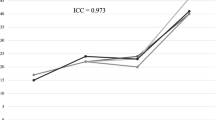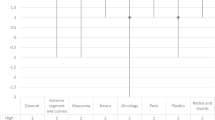Abstract
Purpose
To perform the first head-to-head comparative evaluation of patient education material for obstructive sleep apnoea generated by two artificial intelligence chatbots, ChatGPT and its primary rival Google Bard.
Methods
Fifty frequently asked questions on obstructive sleep apnoea in English were extracted from the patient information webpages of four major sleep organizations and categorized as input prompts. ChatGPT and Google Bard responses were selected and independently rated using the Patient Education Materials Assessment Tool–Printable (PEMAT-P) Auto-Scoring Form by two otolaryngologists, with a Fellowship of the Royal College of Surgeons (FRCS) and a special interest in sleep medicine and surgery. Responses were subjectively screened for any incorrect or dangerous information as a secondary outcome. The Flesch-Kincaid Calculator was used to evaluate the readability of responses for both ChatGPT and Google Bard.
Results
A total of 46 questions were curated and categorized into three domains: condition (n = 14), investigation (n = 9) and treatment (n = 23). Understandability scores for ChatGPT versus Google Bard on the various domains were as follows: condition 90.86% vs.76.32% (p < 0.001); investigation 89.94% vs. 71.67% (p < 0.001); treatment 90.78% vs.73.74% (p < 0.001). Actionability scores for ChatGPT versus Google Bard on the various domains were as follows: condition 77.14% vs. 51.43% (p < 0.001); investigation 72.22% vs. 54.44% (p = 0.05); treatment 73.04% vs. 54.78% (p = 0.002). The mean Flesch–Kincaid Grade Level for ChatGPT was 9.0 and Google Bard was 5.9. No incorrect or dangerous information was identified in any of the generated responses from both ChatGPT and Google Bard.
Conclusion
Evaluation of ChatGPT and Google Bard patient education material for OSA indicates the former to offer superior information across several domains.



Similar content being viewed by others
Data, materials and/or code availability
Data are available on request from the corresponding author.
References
OpenAI (2022) Introducing ChatGPT [Internet]. OpenAI.com. pp 1–11. https://openai.com/blog/chatgpt. Accessed 6 July 2023
Google AI updates: Bard and new AI features in Search [Internet]. Google. (2023). https://blog.google/technology/ai/bard-google-ai-search-updates/. Accessed 6 July 2023
Meskó B, Topol EJ (2023) The imperative for regulatory oversight of large language models (or generative AI) in healthcare. NPJ Digit Med. https://doi.org/10.1038/s41746-023-00873-0
Kung TH, Cheatham M, Medenilla A, Sillos C, De Leon L, Elepaño C et al (2023) Performance of ChatGPT on USMLE: Potential for AI-assisted medical education using large language models. PLOS Digit Health 2(2):e0000198
Patel SB, Lam K (2023) ChatGPT: the future of discharge summaries? Lancet Digit Heal [Internet] 5(3):e107–e108. https://doi.org/10.1016/S2589-7500(23)00021-3
Ali SR, Dobbs TD, Hutchings HA, Whitaker IS (2023) Using ChatGPT to write patient clinic letters. Lancet Digit Heal [Internet]. 5(4):e179–e181. https://doi.org/10.1016/S2589-7500(23)00048-1
Ayoub NF, Lee YJ, Grimm D, Balakrishnan K (2023) Comparison between ChatGPT and google search as sources of postoperative patient instructions. JAMA Otolaryngol Head Neck Surg [Internet] 149(6):556–558
Benjafield AV, Ayas NT, Eastwood PR, Heinzer R, Ip MSM, Morrell MJ et al (2019) Estimation of the global prevalence and burden of obstructive sleep apnoea: a literature-based analysis. Lancet Respir Med 7(8):687–698
Marin JM, Carrizo SJ, Vicente E, Agusti AGN (2005) Long-term cardiovascular outcomes in men with obstructive sleep apnoea-hypopnoea with or without treatment with continuous positive airway pressure: an observational study. Lancet 365(9464):1046–1053
Watson NF (2016) Health care savings: the economic value of diagnostic and therapeutic care for obstructive sleep apnea. J Clin Sleep Med 12(8):1075–1077
Reinventing search with a new AI-powered Microsoft Bing and Edge, your copilot for the web—the Official Microsoft Blog [Internet]. https://blogs.microsoft.com/blog/2023/02/07/reinventing-search-with-a-new-ai-powered-microsoft-bing-and-edge-your-copilot-for-the-web/. Accessed 8 July 2023
Patient-Friendly Guides—American Academy of Sleep Medicine—Association for Sleep Clinicians and Researchers [Internet]. https://aasm.org/clinical-resources/patient-info/patient-friendly-guidelines/. Accessed 12 July 2023
Obstructive Sleep Apnea (OSA) [Internet]. https://www.sleephealthfoundation.org.au/obstructive-sleep-apnea.html. Accessed 12 July 2023
Snoring and Sleep Apnoea | ENT UK [Internet]. https://www.entuk.org/patients/conditions/34/snoring_and_sleep_apnoea. Accessed 12 July 2023
For Patients | International Surgical Sleep Society [Internet]. https://www.surgicalsleep.org/for-patients. Accessed 12 July 2023.
Flesch Kincaid Calculator | Good Calculators [Internet]. https://goodcalculators.com/flesch-kincaid-calculator/. Accessed 20 July 2023
Shoemaker SJ, Wolf MS, Brach C. The patient education materials assessment tool (PEMAT) and user’s guide. Rockville, MD: Agency for Healthcare Research and Quality. 2013 Nov;11.
Introduction | Agency for Healthcare Research and Quality [Internet]. https://www.ahrq.gov/health-literacy/patient-education/pemat1.html. Accessed 15 July 2023
Lyons MM, Bhatt NY, Pack AI, Magalang UJ (2020) Global burden of sleep-disordered breathing and its implications. Respirology 25(7):690–702
Bing vs Google: Search Engine Comparison 2023 | Impression [Internet]. https://www.impressiondigital.com/blog/bing-differ-google/. Accessed 15 July 2023
Internet and social media users in the world 2023 | Statista [Internet]. https://www.statista.com/statistics/617136/digital-population-worldwide/. Accessed 15 July 2023
Alkaissi H, McFarlane SI (2023) Artificial hallucinations in ChatGPT: implications in scientific writing. Cureus 15(2):2–5
ChatGPT and LLMs: what’s the risk—NCSC.GOV.UK [Internet]. https://www.ncsc.gov.uk/blog-post/chatgpt-and-large-language-models-whats-the-risk. Accessed 16 July 2023
Oliffe M, Thompson E, Johnston J, Freeman D, Bagga H, Wong PKK (2019) Assessing the readability and patient comprehension of rheumatology medicine information sheets: a cross-sectional Health Literacy Study. BMJ Open 9(2):1–10
Epic and Microsoft Bring GPT-4 to EHRs [Internet]. https://www.epic.com/epic/post/epic-and-microsoft-bring-gpt-4-to-ehrs. Accessed 6 July 2023
NHS Long Term Plan » The NHS Long Term Plan [Internet]. https://www.longtermplan.nhs.uk/publication/nhs-long-term-plan/. Accessed 7 July 2023
Funding boost for artificial intelligence in NHS to speed up diagnosis of deadly diseases—GOV.UK [Internet]. https://www.gov.uk/government/news/funding-boost-for-artificial-intelligence-in-nhs-to-speed-up-diagnosis-of-deadly-diseases. Accessed 17 July 2023
£21 million to roll out artificial intelligence across the NHS—GOV.UK [Internet]. https://www.gov.uk/government/news/21-million-to-roll-out-artificial-intelligence-across-the-nhs. Accessed 17 July 2023
Funding
No funding was received for conducting this study.
Author information
Authors and Affiliations
Contributions
All authors contributed to the study’s conception and design. Material preparation, data collection and analysis were performed by [RCTC], [SU], [AW] and [VP]. The first draft of the manuscript was written by [RCTC], [SU], [VM], [JJ], [PR], [PA] and [VP] all authors commented on previous versions of the manuscript. All authors read and approved the final manuscript.
Corresponding author
Ethics declarations
Conflict of interest
The authors have no competing interests to declare that are relevant to the content of this article.
Ethics approval
No patient or clinical data was used in this study. No ethical approval required.
Consent
No patient or clinical data was used in this study. No consent is required.
Additional information
Publisher's Note
Springer Nature remains neutral with regard to jurisdictional claims in published maps and institutional affiliations.
Rights and permissions
Springer Nature or its licensor (e.g. a society or other partner) holds exclusive rights to this article under a publishing agreement with the author(s) or other rightsholder(s); author self-archiving of the accepted manuscript version of this article is solely governed by the terms of such publishing agreement and applicable law.
About this article
Cite this article
Cheong, R.C.T., Unadkat, S., Mcneillis, V. et al. Artificial intelligence chatbots as sources of patient education material for obstructive sleep apnoea: ChatGPT versus Google Bard. Eur Arch Otorhinolaryngol 281, 985–993 (2024). https://doi.org/10.1007/s00405-023-08319-9
Received:
Accepted:
Published:
Issue Date:
DOI: https://doi.org/10.1007/s00405-023-08319-9




